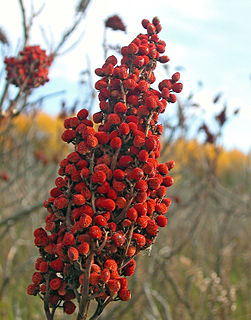
Sumac, also spelled sumach, is any of about 35 species of flowering plants in the genus Rhus and related genera in the cashew family (Anacardiaceae). Sumacs grow in subtropical and temperate regions throughout the world, including East Asia, Africa, and North America. Sumac is used as a spice, as a dye, and in medicine.

Luzula is a genus of flowering plants in the rush family Juncaceae. The genus has a cosmopolitan distribution, with species occurring throughout the world, especially in temperate regions, the Arctic, and higher elevation areas in the tropics. Plants of the genus are known commonly as wood-rush, wood rush, or woodrush. Possible origins of the genus name include the Italian lucciola or the Latin luzulae or luxulae, from lux ("light"), inspired by the way the plants sparkle when wet with dew. Another etymology sometimes given is that it does derive from lucciola but that this meant a mid-summer field, or from the Latin luculus, meaning a small place; the same source also states that this name was applied by Luigi Anguillara in 1561.

Primula hendersonii is a species of flowering plant in the family Primulaceae, native to western North America, from California north to southern British Columbia and Idaho. Common names include broad-leaved shooting star, Henderson's shooting star, mosquito bills, and sailor caps.

Lilium superbum is a species of true lily native to the eastern and central regions of North America. Common names include Turk's cap lily, turban lily, swamp lily, lily royal, or American tiger lily. The native range of the species extends from southern New Hampshire, Massachusetts, and New York, west to Illinois, Missouri, and Arkansas, and south to Georgia, Alabama, Mississippi, and Florida.
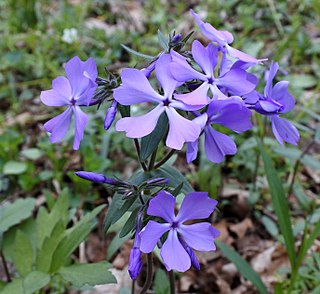
Phlox divaricata, the wild blue phlox, woodland phlox, or wild sweet william, is a species of flowering plant in the family Polemoniaceae, native to forests and fields in eastern North America.

Eurybia divaricata, commonly known as the white wood aster, is an herbaceous plant native to eastern North America. It occurs in the eastern United States, primarily in the Appalachian Mountains, though it is also present in southeastern Canada, but only in about 25 populations in the provinces of Ontario and Quebec. In the U.S. it is abundant and common, but in Canada it is considered threatened due to its restricted distribution. It can be found in dry open woods as well as along wood-edges and clearings. The species is distinguished by its flower heads that have yellow centers and white rays that are arranged in flat-topped corymbiform arrays, emerging in the late summer through fall. Other distinguishing characteristics include its serpentine stems and sharply serrated narrow heart-shaped leaves. The white wood aster is sometimes used in cultivation in both North America and Europe due to it being quite tough and for its showy flowers.

Gaillardia aristata is a North American species of flowering plant in the sunflower family, known by the common names common blanketflower and common gaillardia. This perennial wildflower is widespread across much of North America, from Yukon east to Québec and south as far as California, Arizona, Illinois, and Connecticut, although it may be naturalized rather than native in parts of that range. It is also naturalized in scattered locations in Europe, Australia, and South America.
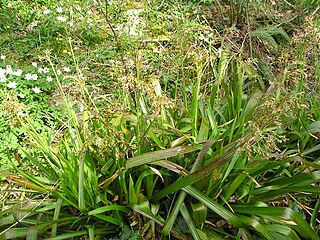
Luzula sylvatica, commonly known as greater wood-rush or great wood-rush, is a perennial flowering plant in the rush family Juncaceae.

Carex luzulina is a species of sedge known by the common name woodrush sedge.
Luzula orestera, with the common name Sierra woodrush, is a species of flowering plant in the rush family. It is endemic to the High Sierra Nevada of California, where it grows in fellfields, talus, and other habitat in regions of subalpine and alpine climates.
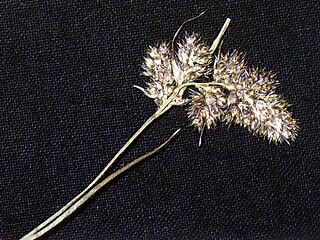
Luzula spicata is a species of flowering plant in the rush family known by the common name spiked woodrush. It has a circumpolar distribution, occurring throughout the northern Northern Hemisphere in Europe, Asia, and North America. It grows in subalpine and alpine climates. It occurs at low elevations in colder regions, such as tundra; farther south it is restricted mainly to high mountains. It is a perennial herb forming grasslike clumps of several erect, reddish stems up to about 33 centimeters in maximum height. The stem is thick and its base is buried several centimeters in the soil where it attaches to the roots. The inflorescence is an array of several clusters of brown bristle-tipped flowers. The surrounding bracts and the sheaths surrounding the leaf bases are lined with hairs.

Luzula multiflora, the common woodrush or heath wood-rush, is a species of flowering plant in the rush family.

Elachista trapeziella is a moth of the family Elachistidae found in Europe.
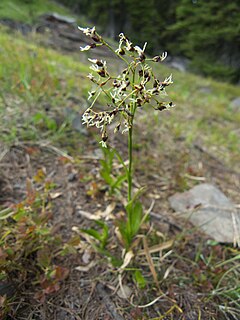
Luzula hitchcockii is a species of flowering plant in the rush family known by the common names smooth woodrush and Hitchcock's wood rush. It is native to western North America from British Columbia and Alberta to Oregon to Wyoming. It is sometimes treated as a variety of Luzula glabrata.
Agalinis divaricata is a flowering plant species in the genus Agalinis. It is commonly known as pineland false foxglove. A dicot, it grows in parts of Florida, Georgia and Alabama. It is in the Orobanchaceae (broomrape) family. It grows in dry longleaf pine forests and savannahs. The genus is hemiparasitic.
Luzula confusa is a species of rush belonging to the family Juncaceae.
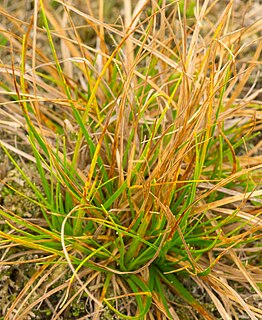
Carex umbellata, the parasol sedge, is a species of flowering plant in the genus Carex, native to Canada and the central and eastern US, and introduced to the Dominican Republic. Its seeds are dispersed by ants.
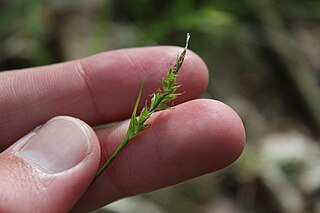
Carex communis, the fibrous-root sedge, is a species of flowering plant in the genus Carex, native to central and eastern Canada and the central and eastern United States. Its seeds are dispersed by ants.
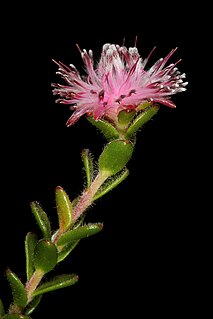
Diastella divaricata is a flower-bearing shrub that belongs to the genus Diastella and forms part of the fynbos. The plant is native to the Western Cape and is found on the Cape Peninsula south of the Silvermine Nature Reserve. The shrub is flat and grows only 50 cm high but 3 m in diameter and flowers throughout the year without an obvious peak.
Sclerolaena divaricata, the tangled copper-burr, is a species of flowering plant in the family Amaranthaceae, native to southeastern Australia. A rounded perennial shrub, it has terete leaves.















